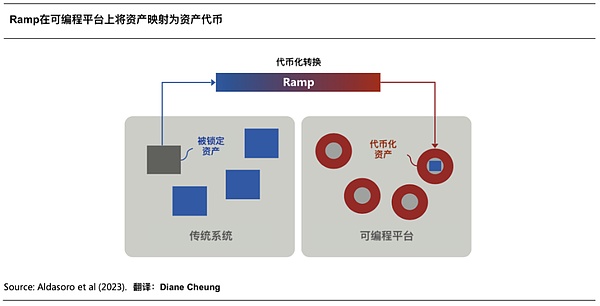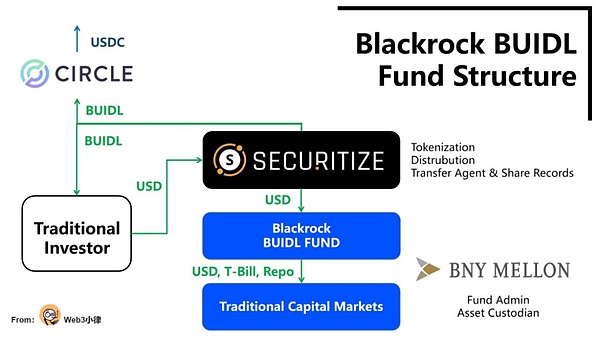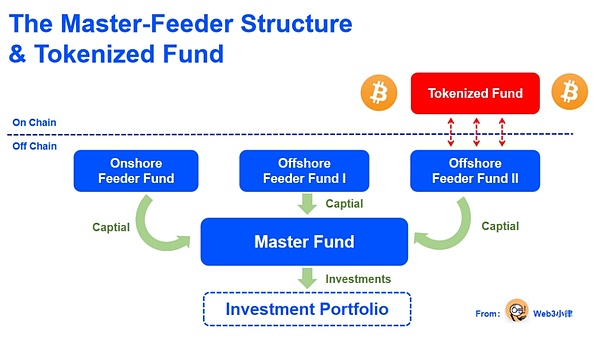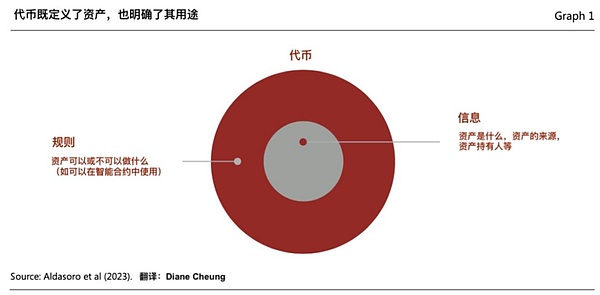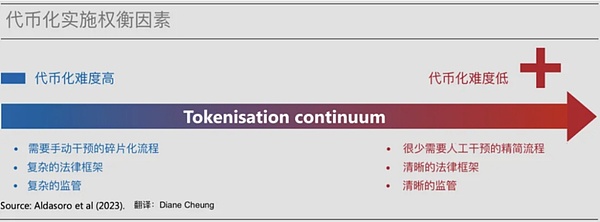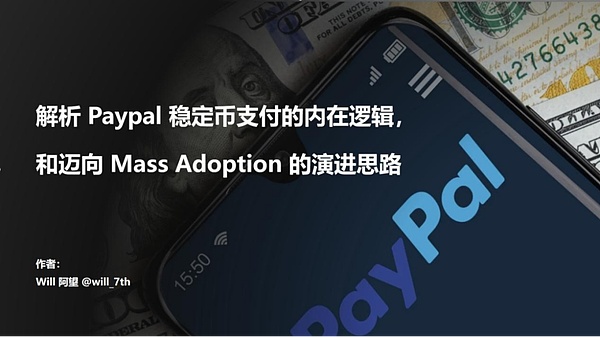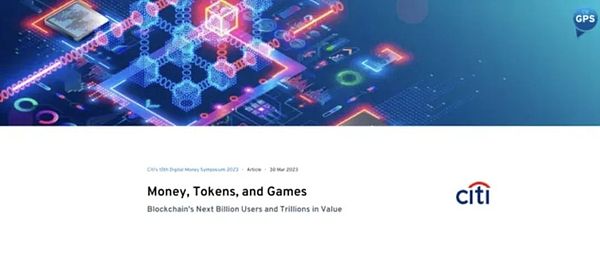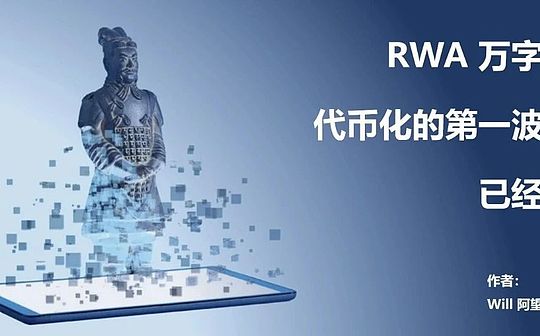
Author: Will Awang
If I were to imagine how finance would work in the future, I would undoubtedly introduce many advantages that digital currency and blockchain technology can bring: 7/24 all-weather availability, instant global liquidity, fair access without permission, asset composability, and transparency in asset management.This imagined future financial world is gradually being built through tokenization.
Blackrock CEO Larry Fink emphasized the importance of tokenization for future finance in early 2024: “We believe that the next step in financial services will be tokenization of financial assets, which means every stock, every bond, everyAll financial assets will run on the same ledger.”
Asset digitalization can be fully rolled out with the maturity of technology and measurable economic benefits, but the large-scale and widespread adoption of asset tokenization will not be achieved overnight.The most challenging point is that in a strictly regulated industry, financial services, the transformation of traditional finance infrastructure requires the participation of all players across the entire value chain.
Nevertheless, we have been able to see the first wave of tokenization coming, mainly benefiting from the return on investment in the current high interest rate environment, and the actual use case drive of existing scales (such as stablecoins, tokenized US bonds).The second wave of tokenization may be driven by the use cases of asset classes that are currently under market share, less significant returns or need to address more severe technological challenges.
This article attempts to examine the potential benefits and long-standing challenges that tokenization can bring from the perspective of traditional finance through McKinsey & Co’s analysis framework for tokenization, while combining realistic and objective cases, we conclude that despite the challengesStill exists, the first wave of tokenization has arrived.
TL;DR
Tokenization refers to the process of creating a digital representation of assets on the blockchain;
Tokenization brings many advantages: 7/24 all-weather availability, instant global liquidity, licensing fair access, asset composing, and transparency in asset management;
In the field of financial services, the focus of tokenization is shifting toward “blockchain, not cryptocurrency”;
Despite the challenges, with the rapid adoption of stablecoins, the major launch of tokenized US bonds, and the clear regulatory framework, the first wave of tokenization has arrived;
McKinsey expects the total market capitalization of the tokenized market could reach about $2 trillion – 4 trillion by 2030 (excluding the market capitalization of cryptocurrencies and stablecoins);
Comparing the tokenized market status with significant paradigm shifts in other technologies shows that we are in the early stages of the market;
The next wave of tokenization may be led by financial institutions and market infrastructure players.

1. What is tokenization?
“Tokenization” refers to the process of recording the ownership of financial or real assets existing on traditional ledgers to a blockchain programmable platform to create a digital representation of assets.These assets can be traditional tangible assets (such as real estate, agricultural or mining commodities, simulated artwork), financial assets (stocks, bonds), or intangible assets (such as digital art and other intellectual property).
The resulting “token” refers to the ownership certificates (claims) recorded on the blockchain programmable platform.Tokens are not just a single digital voucher, but tokens usually combine rules and logic that manage the transfer of underlying assets in traditional ledgers.Therefore, the tokens are programmable and customizable to meet the requirements of personalized scenarios and regulatory compliance.
(Tokenization and unified account book – building a blueprint for future monetary system)
The “tokenization” of assets involves the following four steps:
1.1 Determine the underlying assets
The process begins when the asset owner or issuer determines that the asset will benefit from tokenization.This step requires clarification of the structure of tokenization, as specific details will determine the design of the entire tokenization scheme, such as tokenization of money market funds different from tokenization of carbon credits.The design of tokenization schemes is crucial, which helps to clarify whether tokenized assets will be considered as securities or commodities, which regulatory frameworks will apply, and which partners will be partnered with.
1.2 Token Issuance and Hosting
To create a digital representation of assets based on blockchain, you need to first lock in the corresponding underlying assets of the digital representation.This will involve the need to transfer assets to a range that can be controlled (whether physical or virtual), usually by a qualified custodian or licensed trust company.
Then, a specific form of token is used on the blockchain to create a digital representation of the underlying assets, which have embedded functions for code that executes predetermined rules.To do this, asset owners choose specific token standards (ERC-20 and ERC-3643 are common standards), network (private or public blockchains), and features to be embedded (e.g., user transfer restrictions, freezing functions and chases), the above functions can be implemented through tokenized service providers.
1.3 Token allocation and trading
Tokenized assets can be distributed to final investors through new channels such as traditional channels or digital asset exchanges.Investors need to establish an account or wallet to hold digital assets, and any physical asset equivalent is still locked in the issuer’s account of the traditional custodian.This step usually involves distributors (for example, the private wealth department of large banks) and transfer agents or transaction brokers.
Depending on the issuer and asset class, it can also be listed through secondary market trading venues to create a liquid market for these tokenized assets after issuance.
1.4 Asset Services and Data Verification
Digital assets distributed to the final investor still require ongoing services, including regulatory, tax and accounting reporting, and regular calculation of net asset value (NAV).The nature of the service depends on the asset class.For example, the service of carbon credit tokens requires a different audit than fund tokens.Services need to coordinate off-chain and on-chain activities to handle a wide range of data sources.
The current tokenization process is relatively complex. In a money market fund tokenization plan, up to nine parties will be involved (asset owner, issuer, traditional custodian, tokenization provider, transfer agent, and digital asset custody.People or trading brokers, secondary markets, distributors and end investors) have two more parties than traditional asset processes.
2. Advantages of tokenization
Tokenization can allow assets to obtain the huge potential brought by digital currency and blockchain technology.Broadly speaking, these advantages include: 7/24 all-week operation, data availability, and so-called Atomic Settlement.In addition, tokenization provides programmability—that is, the ability to embed code in tokens, and the ability to interact with smart contracts (composibility)—to achieve a higher degree of automation.
More specifically, when asset tokenization is promoted on a large scale, in addition to proof of concept, the following advantages will become increasingly prominent:
2.1 Improve capital efficiency
Tokenization can significantly improve the capital efficiency of assets in the market.For example, a tokenized Repurchase Agreements (Repo) or a Money Market Fund redemption can be completed instantly in a few minutes, while the current traditional settlement time is T+2.In order to achieve a large amount of money in the current high interest rate market environment, shorter settlement times can save you.For investors, these savings in capital rates may be the reason why the recent tokenized US bond projects can have a huge impact in the near future.
On March 21, 2024, Blackrock and Securities teamed up to launch the first tokenized fund BUIDL on the public blockchain, Ethereum.After the fund tokenization, it can realize real-time settlement of unified account books on the chain, which greatly reduces transaction costs and improves capital efficiency. It can realize (1) 24/7/365 fund subscription/redemption of fiat currency USD, such instant settlement., the real-time redemption function is a point that many traditional financial institutions are eager to achieve; at the same time, they cooperate with Circle to achieve real-time redemption of (2) stablecoin USDC and fund token BUIDL 1:1.
This tokenized fund that can link traditional finance and digital finance is a milestone innovation for the financial industry.
(Analysis of Blackrock tokenized fund BUIDL of Blackrock, opening up a beautiful new world to DeFi for RWA assets)
2.2 Unauthorized democratic visits
One of the most hailed benefits of tokenization or blockchain is the democratization of access, a feature of the permissionless entry threshold in token fragmentation (i.e., dividing ownership into smaller shares and lowering investment thresholds)After that, asset liquidity may be improved, but the premise is that the tokenized market can be popularized.
In some asset classes, simplifying intensive manual processes through smart contracts can significantly improve unit economic benefits, thus providing services to smaller investors.However, access to these investments may be subject to regulatory restrictions, meaning many tokenized assets may only be available to qualified investors.
We can see that the famous private equity giants Hamilton Lane and KKR cooperated with Securities respectively tokenize the Feeder Fund, which manages private equity funds, providing investors with a “parity” way to participate in top private equity funds with the lowest investment by investingThe threshold has dropped significantly from the average of $5 million to only $20,000, but individual investors still have to pass the Qualified Investor Verification of the Security platform, and there are still certain thresholds.
(RWA ten thousand-word research report: the value, exploration and practice of fund tokenization)
2.3Save operational costs
Asset programmability can be another source of cost savings, especially for asset classes that are often highly manual, error-prone and involve numerous intermediaries, such as corporate bonds and other fixed income products.These products usually involve customized structures, inaccurate interest calculations and coupon payment expenses.Embedding operations such as interest calculation and coupon payment into smart contracts in tokens will automate these functions and greatly reduce costs; system automation achieved through smart contracts can also reduce the costs of services such as securities lending and repurchase transactions.
The Evergreen project was launched in 2022 with the Bank for International Settlements (BIS) and the Hong Kong Monetary Authority, which uses tokenization and unified ledgers to issue green bonds.The project makes full use of distributed unified ledgers to integrate participants involved in bond issuance on the same data platform, supports multi-party workflows and provides authorization, real-time verification and signature functions of specific participants, improving transaction processing efficiency, and bondsDelivery has achieved DvP delivery, reducing delivery delays and delivery risks, and the platform’s real-time data updates to participants also improve transaction transparency.
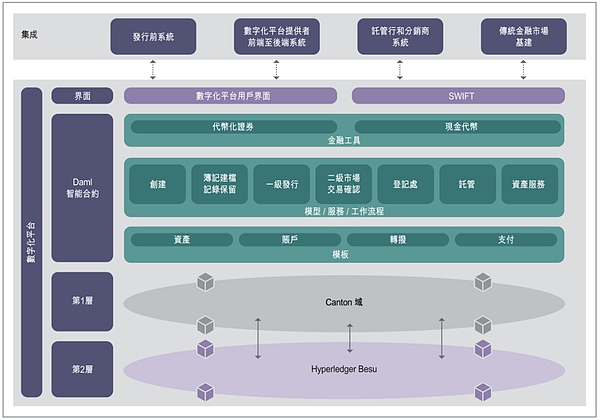
(https://www.hkma.gov.hk/media/chi/doc/key-information/press-release/2023/20230824c3a1.pdf)
Over time, tokenized asset programmability can also create benefits at the portfolio level, allowing asset managers to automatically rebalance their portfolios in real time.
2.4 Enhanced compliance, auditability and transparency
Current compliance systems often rely on manual inspection and retrospective analysis.An asset issuer can automate these compliance checks by embedding specific compliance-related actions (e.g., transfer restrictions) into tokenized assets.Additionally, 24/7 data availability based on blockchain systems creates opportunities for simplified consolidated reporting, immutable record preservation and real-time auditability.
(Tokenization and unified account book – building a blueprint for future monetary system)
An intuitive case is Carbon Credits, which provides credit purchases, transfers and exits with untampered and transparent records, and builds transfer restrictions and measurement, reporting and verification (MRV) capabilities into the generationCoin in smart contract.In this way, when a carbon token transaction is initiated, the token can automatically check the latest satellite images to ensure that the energy-saving and emission reduction projects at the bottom of the token are still in operation, thereby enhancing the trust of the project and its ecosystem.
2.5 Cheaper and more flexible infrastructure
Blockchain is essentially open source, growing driven by thousands of Web3 developers and billions of dollars in venture capital.Assuming that financial institutions directly choose to operate on public permissionless blockchains, or public/private hybrid blockchains, innovations in blockchain technologies (such as smart contracts and token standards) can be easily and quickly adopted,This further reduces operating costs.

(Tokenization: A digital-asset déjà vu)
Given these advantages, it is not difficult to understand why many large banks and asset management companies are so interested in the prospects of this technology.
However, due to insufficient use cases and adoption scale of tokenized assets, some of the listed advantages remain theoretically.
3. Large-scaleChallenges facing adoption
Although tokenization may bring many benefits, few assets have been tokenized on a large scale so far, with potential influencing factors as follows:
3.1Inadequate technology and infrastructure preparation
The adoption of tokenization is hampered by restrictions on existing blockchain infrastructure.These limitations include an ongoing shortage of institutional-level digital asset custody and wallet solutions that do not provide sufficient flexibility to manage account policies, such as transaction limits.
In addition, blockchain technology, especially public blockchains that do not require permission, has limited ability to operate the system properly under high transaction throughput, and this flaw cannot support the tokenization of certain use cases, especially in mature capital marketsmiddle.
Finally, decentralized private blockchain infrastructure, including developer tools, token standards and smart contract guidelines, presents risks and challenges to interoperability among traditional financial institutions, such as interoperability between chains., cross-chain protocol, liquidity management, etc.
3.2 CurrentLimited business cases, high cost of implementation
When tokenized assets reach a certain scale, many potential economic benefits of tokenization will be realized on a large scale.However, this may require an education cycle to transition and adapt to the middle and back-end workflows that are not designed for tokenized assets.This situation means that short-term interests are unclear and that business cases are difficult to gain organizational recognition.
Not everyone can master digital currency and blockchain technology from the beginning. Operations during the transition period will appear complex and may involve the operation of two systems simultaneously (for example, digital and traditional settlement, on-chain and chaindata coordination and compliance, digital and traditional custody and asset services).
Finally, many traditional customers in the capital market have not yet shown interest in infrastructure for 24/7 trading, and increased value liquidity, which poses further challenges to the way to market tokenized products.
3.3marketSupporting facilities are in placeMature
Tokenization requires quicker settlement time and higher capital efficiency, instant cash settlement is required.However, despite the progress made in this regard, there is currently no large-scale cross-bank solution: tokenized deposits are currently piloted within only a few banks, and stablecoins currently lack regulatory clarity and cannot be considered anonymousAssets, cannot provide real-time ubiquitous settlement.Secondly, tokenized service providers are still in their infancy and do not have the ability to provide comprehensive and mature one-stop services for the time being.Furthermore, the market lacks large-scale distribution channels for appropriate investors to access digital assets, which is in stark contrast to the mature distribution channels used by wealth and asset managers.
3.4Regulatory uncertainty
To date, the regulatory framework for tokenization has changed by region or simply not exists.Challenges faced by U.S. participants include unclear settlement finality, lack of legal binding force in smart contracts, and unclear requirements for qualified trustees.There are still more unknowns about capital processing of digital assets.For example, the U.S. Securities and Exchange Commission passed the SAB 121 rule that when providing custody services, digital assets must be reflected in the balance sheet—a standard that is stricter than traditional assets, allowing banks to hold or even distribute digital assets.The cost is too high.
3.5Industry needs coordination
Capital market infrastructure participants have not shown a unanimous willingness to build a tokenized market or transfer the market to the chain, and their participation is crucial because they are the ultimate recognized holders of assets on the ledger.The driving force of moving to new on-chain infrastructure through tokenization is not consistent across all parties, especially considering that the functions of many financial intermediaries here will undergo significant changes and may even be de-mediated.
Even if carbon credit, as a relatively new asset class, has encountered challenges in the initial establishment and operation of blockchain.Although tokenization can bring obvious benefits such as enhanced transparency, it seems that Gold Standard is the only registered institution that publicly supports tokenized carbon credits.
Four,TokenizationThe first wave has arrived
Despite the many challenges mentioned above, as well as unknown unknowns, we can see from the trends and large-scale adoption in recent months that tokenization has reached a turning point in certain asset classes and their use cases, tokenizationThe first wave has arrived (Tokenization in Waves).
4.1 Stable CoinofLarge adoption
7/24 Tokenized assets with all-weather and instant settlement must be supported by tokenized cash, and the representative of tokenized cash, stablecoins, is the most important link in the tokenized market.
Stablecoin definition: Most word currencies have a lot of price fluctuations and are not suitable for payment, just like Bitcoin may experience a large amplitude in a day.And stablecoins are digital currencies designed to solve this problem by maintaining stable value, often pegged to fiat currencies (such as the US dollar).Stablecoins have the best of both worlds: They maintain low daily volatility while providing the advantages of blockchain – efficient, economical and globally versatile.
According to SoSoValue data, about $153 billion in tokenized cash is currently circulating in the form of stablecoins (such as USDC, USDT).Some banks have launched or are about to launch the tokenized Deposit feature to improve the cash settlement process of commercial transactions.These nascent systems are by no means perfect; liquidity remains scattered and stablecoins are not yet recognized as bearer assets.Even so, they have proven sufficient to support meaningful trading volumes in the digital asset market.The on-chain volume of stablecoins usually exceeds $500 billion per month.
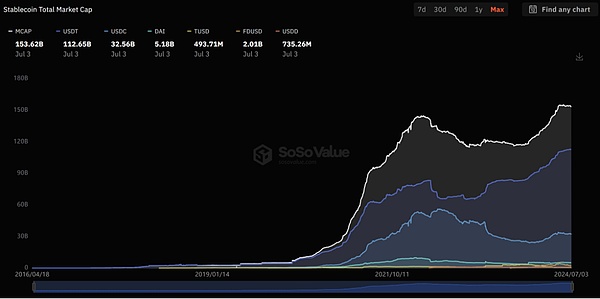
(https://sosovalue.xyz/dashboard/Stablecoin_Total_Market_Cap)
4.2 Tokenized US bonds under short-term business demands
The current high interest rate environment has made tokenized use cases based on US bonds attract a lot of attention from the market, and its products can indeed achieve economic benefits and improve capital efficiency.According to RWA.XYZ data, the tokenized US bond market size has risen from US$770 million at the beginning of 2024 to US$1.75 billion today (as of July 1), an increase of 227%.
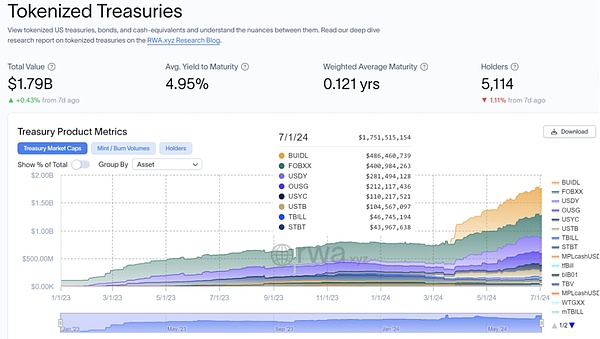
(https://app.rwa.xyz/treasuries)
Meanwhile, short-term liquidity trading (such as tokenized repurchases and securities lending) is more attractive when interest rates rise.Onyx, JPMorgan’s institutional-level blockchain payment network, is currently able to process $2 billion in transactions per day.Onyx’s transaction volume can be attributed to JPMorgan’s “Coin System” and “Digital Asset” solutions.
In addition, in the United States, traditional banks have welcomed a group of large (usually lucrative) digital asset business customers, such as stablecoin issuers.Retaining these customers requires 24/7 value and tokenized cash flows, which further facilitates business cases that accelerate tokenization capabilities.
4.3 Gradually clarify the tokenized regulatory framework
At the end of June, the EU had implemented regulatory requirements for stablecoins in the Crypto Asset Market Supervision Act (MiCA), and Hong Kong is also seeking opinions on the implementation of stablecoins. New regions including Japan, Singapore, the UAE and the United Kingdom have also released newGuidelines to improve regulatory transparency of digital assets.Even in the United States, market participants are exploring various tokenization and distribution methods, leveraging existing rules and guidance to mitigate the impact of current regulatory uncertainty.
Following June 7, the House Subcommittee on Digital Assets, Financial Technology and Inclusion held a hearing on “Next Generation Infrastructure: How to Promote the Effective Operation of Markets Through Tokenization of Real-World Assets?”On the 14th, SEC Commissioner Mark Uyeda emphasized the potential of tokenization to change the capital market in a securities market event.Especially with the advancement of this important issue of digital currency in the US election process, whether it is the demand for financial innovation or the relaxation of regulation, traditional financial capital’s attention to digital currency has shifted from the previous negative “speculation” to how to “positive”local transformation of traditional finance.
4.4 Market popularity and infrastructure maturity
Over the past five years, many traditional financial services companies have added digital asset talent and capabilities.Several banks, asset management companies and capital market infrastructure companies have established digital asset teams of 50 or more people, and these teams are growing.At the same time, veteran market participants are constantly improving their understanding of this technology and its prospects.
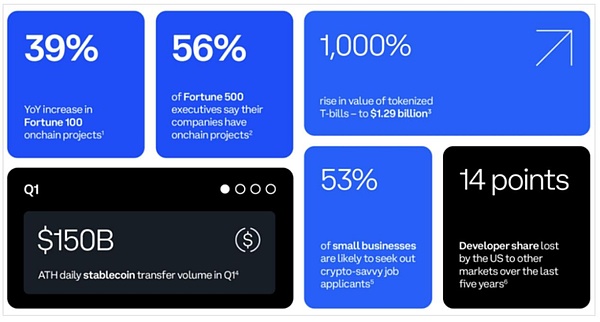
(Coinbase, The State of Crypto: The Fortune 500 Moving Onchain)
According to Coinbase’s second-quarter cryptocurrency status report, 35% of Fortune 500 companies are considering launching tokenization projects.Executives of the top 10 top 500 companies are learning more about stablecoin use cases, mainly for low-cost, real-time settlement of stablecoin payments.86% of the Top 500 executives recognize the potential benefits of asset tokenization for their companies, and 35% of the Top 500 executives say they are currently planning to launch tokenization projects (including stablecoins).
In addition, we are currently seeing more trials and planned feature expansions in some important financial market infrastructures, such as processing over $2,000 trillion in transactions per year on May 16, the world’s largest securities settlement system——The US Custody Trust and Clearing Corporation (DTCC) and blockchain oracle Chainlink completed the pilot Smart NAV project. The project uses Chainlink’s cross-chain interoperability protocol CCIP to implement the introduction on almost all private or public blockchains.Net Asset Value (NAV) Quotation Data for Mutual Funds.
Market participants in the pilot include Century Investment Corporation, Bank of New York Mellon, Edward Jones, Franklin Templeton, Invesco, JPMorgan Chase, MFS Investment Management, Mid-Atlantic Trust, State Street and Bank of America.The pilot found that by providing structured data on the chain and creating standard roles and processes, the basic data can be embedded in a variety of on-chain use cases, opening up a variety of innovative application scenarios for the tokenization of funds.
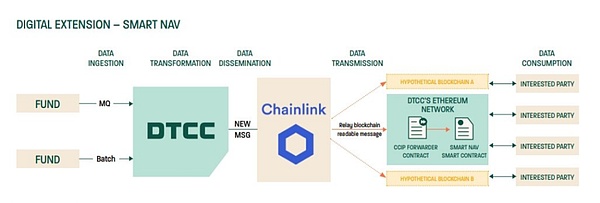
(DTCC, Smart NAV Pilot Report: Bringing Trusted Data to the Blockchain Ecosystem)
While tokenization has not yet reached the scale required to deliver on all its benefits, the ecosystem is maturing, potential challenges are becoming clearer, and business cases of adopting tokenization are gradually increasing.
Especially now, the argument that tokenization can improve capital efficiency has been successfully launched on Blackrock (traditional financial perspective) and Ondo Finance tokenized US bond products (crypto finance)The massive adoption of $ONDO tokens has been strongly supported in real-life cases.It can be said that the first wave of tokenization has arrived.
As for the argument that subsequent tokenization can provide liquidity for traditional illiquid assets, it needs further proofread by the market.This argument will be built on the large-scale adoption of tokenized assets.
In any case, these realistic use cases show that tokenization can continue to gain attention and create positive and meaningful value for global markets over the next two to five years.
5. The most widely adoptedAsset Category
Asset categories with large market size, high value chain friction, imperfect traditional infrastructure, or low liquidity may be most likely to gain huge benefits from tokenization.But the most likely profit does not mean that the most priority can be implemented.
The adoption rate and launch timing of tokenization will vary depending on the attributes of the asset class, and their expected returns, feasibility of implementation, impact timing, and risk preferences of market participants.These factors will determine whether and when the relevant asset classes can be adopted on a large scale.
Specific asset classes can lay the foundation for subsequent adoption of other asset classes by introducing clearer regulation, more mature infrastructure, better interoperability and faster and more convenient investment.Adoption will also vary by region and be affected by dynamic and changing macro environments, including market conditions, regulatory frameworks and buyer needs.Finally, success or failure of celebrity projects may drive or limit further adoption of tokenization.
(Tokenization and unified account book – building a blueprint for future monetary system)
5.1 Mutual Fund
Tokenized money market funds have attracted more than $1 billion in managed assets, indicating that investors with on-chain capital have a high interest rate environment have a large demand for tokenized money market funds.Investors can choose funds managed by established companies, such as Blackrock, WisdomTree, Franklin Templeton, and Web3 native projects such as Ondo Finance, Superstate, and Maple Finance.These tokenized money market funds have basically all U.S. bonds.
This is the first wave of tokenization at present, that is, the large-scale adoption of tokenized funds. As the scope and scale of tokenized funds continue to expand, additional related product and operational advantages will be realized.
Just as Paypal launched its stablecoin at Solana at the end of May, it means: the first step towards mass adoption is cognitive awakening—that is, simply introducing people to the fact that new technologies exist;The next step is to realize the utility, that is, to transform the initial cognitive awakening into the utility in real life.Paypal’s idea of promoting its stablecoins can also be used in the large-scale adoption of the tokenized market.
(Analysis of the internal logic of Paypal stablecoin payment and the evolutionary ideas towards Mass Adoption)
The transition to on-chain tokenized funds can greatly improve the practicality of funds, including instant execution 24/7, instant settlement, and the use of tokenized fund shares as payment tools.In addition, based on on-chain composability, Web3 native project issuers are improving the utility of tokens based on their own characteristics.For example, Superstate, the team behind $USTB (founded by Compound founder), announced that their tokens can now be used to secure transactions on FalconX.Ondo Finance, the team behind $USDY and $OUSG, announced that $USDY can now be used to secure perpetual contract transactions that secure Drift Protocol.
In addition, a highly customized investment strategy will become possible through the composability of hundreds of tokenized assets.Putting data on a shared ledger can reduce errors related to manual checks and increase transparency, thus reducing operational and technical costs.
While the overall demand for tokenized money market funds depends in part on the interest rate environment, it undoubtedly plays a crucial role in promoting the development of tokenized markets.Other types of mutual funds and ETFs can also provide on-chain capital diversification for traditional financial instruments.
5.2 Private Credit
Although blockchain-based private credit is still in its infancy, disruptors have begun to succeed in this area: Figure Technologies is one of the largest non-bank home equity line (HELOC) lenders in the United States, with loans issuedBillions of dollars.Web3 native projects such as Centrifuge and Maple Finance, together with companies such as Figure, have led to the issuance of more than $10 billion in on-chain credit.
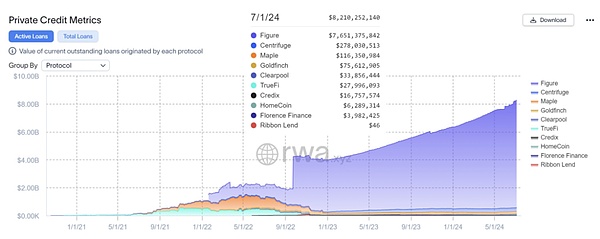
(https://app.rwa.xyz/private_credit)
The traditional credit industry is a process labor-intensive industry with high intermediary participation and high entry threshold.Blockchain-based credit provides an alternative with many advantages: real-time on-chain data, stored in a unified general ledger, as a single source of facts, promoting transparency and standardization throughout the loan life cycle.Smart contract-based spending calculations and simplified reporting reduce the cost and labor required.Shortening settlement cycles and accessing a wider pool of funds can speed up the transaction process and may reduce the cost of funds for borrowers.
Most importantly, global liquidity can fund on-chain credit without permission.In the future, tokenizing borrowers’ financial metadata or monitoring their on-chain cash flow can achieve full automation, equitable and accurate financing of projects.As a result, more and more loans are turning to private credit channels, and financing cost savings and fast and efficient are extremely attractive to borrowers.
Private credit, a non-standardized business, may have more explosive potential, and the CEO of Securities has also clearly expressed optimism about the development of the tokenized private credit industry.
5.3 Bonds
Over the past decade, tokenized bonds have been issued in the world with a total nominal value of more than $10 billion (and the total outstanding nominal bonds worldwide are $140 trillion).Recent issues worthy of attention include Siemens, City of Lugano and World Bank, as well as other companies, government-related entities and international organizations.In addition, blockchain-based repo transactions (Repo) have been adopted, with monthly transaction volumes in North America reaching trillions of dollars and creating value through the operational and capital efficiency of existing capital flows.
Digital bond issuance may continue because once scaled up, its potential returns will be high and the current threshold is relatively low, partly due to the desire to stimulate the development of capital markets in certain regions.For example, in Thailand and the Philippines, issuing tokenized bonds allows small investors to participate through diversification.
While the advantages thus far are mainly reflected in issuance, the end-to-end tokenized bond life cycle can be through data clarity, automation, embedded compliance (e.g., code-programming transferability rules into tokens) andStreamlining processes (e.g., asset intermediary services) improves operational efficiency by at least 40%.In addition, reducing costs, speeding up issuance or fragmenting assets can improve financing for small issuers by achieving “instant” financing (i.e. optimizing borrowing costs by raising specific amounts at a specific time) and using the global capital pool to expand the investor base.
5.4 Repurchase transactions
Repo Agreements (Repo) are an example of the tokenization adoption and its benefits that can be observed today.Broadridge Financial Solutions, Goldman Sachs and JPMorgan Chase are currently trading trillions of dollars in monthly buybacks.Unlike some tokenization use cases, repurchase transactions do not require the entire value chain to be tokenized to achieve real benefits.
Financial institutions that repurchase tokenize their repurchase mainly achieve operational and capital efficiency.Operationally, supporting the execution of smart contracts can automate daily life cycle management (e.g. collateral valuation and margin replenishment), which reduces system errors and settlement failures and simplifies reporting.At the level of capital efficiency, 7/24 is settled instantly, and real-time analysis of on-chain data can meet intraday liquidity requirements through short-term lending, while enhancing collateral to improve capital efficiency.
Historically, most repo agreements have a duration of 24 hours or more.Intraday liquidity can reduce counterparty risks, reduce borrowing costs, achieve short-term incremental borrowing, and reduce liquidity buffering.
Real-time, all-weather, cross-jurisdictional collateral flows can provide channels for higher yield, high-quality current assets and enable these collateral to be optimized between market participants, thus maximizing their availability.
6. After the first wave of tokenization
The tokenization market is currently advancing steadily, and it is expected to accelerate its development as the network effect increases.Given its characteristics, some asset classes may enter a phase of realistic massive adoption faster, i.e., their tokenized assets exceed $100 billion by 2030.
McKinsey expects the first asset classes that can be realized will include cash and deposits, bonds, public funds, ETFs, and private credit.For cash and deposits (stablecoin use cases), adoption rates are already high, thanks to the high efficiency and value benefits brought by blockchain, as well as higher technical and regulatory feasibility.
McKinsey estimates that tokenized market caps for all asset classes may reach about $2 trillion by 2030, with pessimistic and optimistic scenarios ranging from about $1 trillion to about $4 trillion, respectively, driven primarily by the following assets.This estimate does not include stablecoins, tokenized deposits, and central bank digital currency (CBDC).
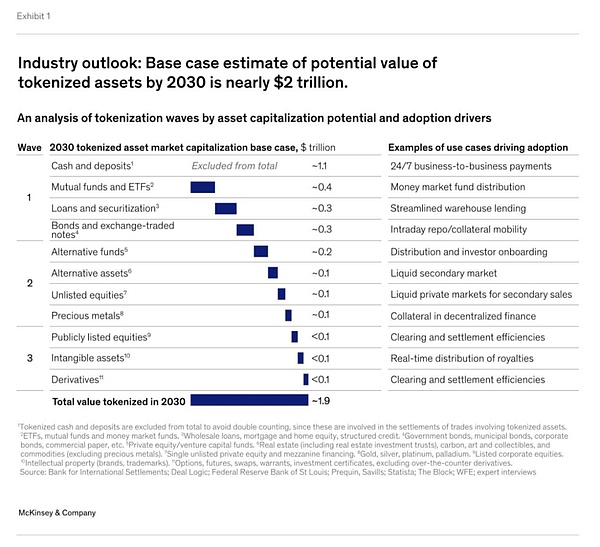
(From ripples to waves: The transformative power of tokenizing assets)
Previously, Citi also predicted that in its research reports on money, tokens and games (the next billion users of blockchain and ten trillion value) that in its tokenized cash, the tokenized market size will be expected by 2030.It will reach $5 trillion.
(Citi RWA Research Report: Money, Tokens and Games (the next billion users of blockchain and the value of 10 trillion))
The first wave of tokenization described above has completed the arduous task of its large-scale market popularity. Tokenization in other asset classes may only appear after the foundations of the previous first wave of asset tokenization, or a clear catalyst appears.It is more likely to expand the scale in the case of
For several other asset classes, adoption may be slower, either because expected returns are only incremental or due to feasibility issues such as difficulty meeting compliance obligations or lack of incentives for key market participants.These asset classes include publicly traded and unlisted stocks, real estate and precious metals.
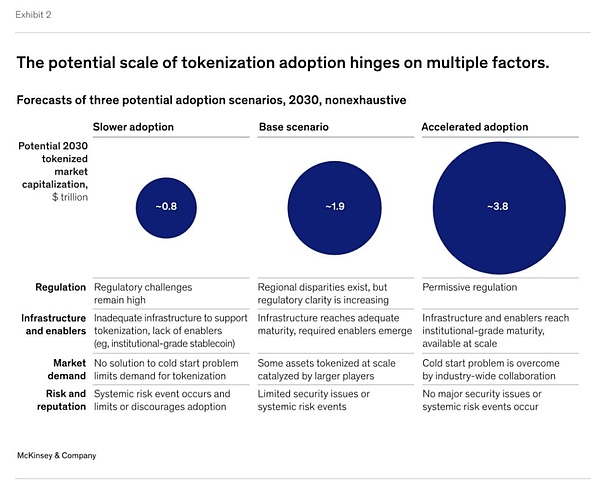
(From ripples to waves: The transformative power of tokenizing assets)
7. How should financial institutions respond
Regardless of whether tokenization is at a turning point or not, a natural question is how financial institutions should respond to this moment.The specific time frame and final adoption of tokenization are not clear, but early institutional experiments on certain asset classes and use cases (such as money market funds, buybacks, private equity funds, corporate bonds) show that tokenization will be two to the next.There is potential to expand within five years.Those who want to ensure a leading position in this ecosystem can consider the following steps.
7.1 Re-examine basic business cases
Institutions should reevaluate the specific advantages and value propositions of tokenization, as well as the implementation approaches and costs.Understanding the impact of higher interest rates and volatile open markets on a particular asset or use case is critical to properly assessing the potential advantages of tokenization.Similarly, constantly exploring the provider landscape and understanding the early applications of tokenization will help refine estimates of the cost and benefits of the technology.
7.2 Establishing technical and risk capabilities
No matter where existing institutions are in the tokenized value chain, in order to welcome a new wave, they must reserve knowledge and ability.First and foremost is to establish a basic understanding of tokenization technology and its associated risks, especially regarding blockchain infrastructure and governance responsibilities (who can approve what and when), token design (restrictions on assetsand the implementation of these restrictions) and system design (decisions regarding the location of books and records and their impact on the nature of asset holders).Understanding these basic principles can also help stay proactive in subsequent communication with regulators and clients.
7.3 Establish ecosystem resources
Given the current relatively fragmented pattern of the digital world, institutional leaders must develop ecosystem strategies in a timely manner in order to integrate them into other (traditional) systems and partners to maintain their dominance.
7.4 Participate in standard formulation
Finally, institutions that hope to take the lead in tokenization should maintain communication with regulators and provide suggestions on emerging standards.Some examples of key areas that can be considered for developing standards include control (i.e., appropriate governance, risk and control frameworks to protect end investors), custody (what constitutes qualified custody of tokenized assets on private networks, and when to use digital twins and digitalNative records, what is a good control location), token design (which types of token standards and related compliance engines are supported), and blockchain support and data standards (which data is stored on the chain rather than off-chain,reconciliation standards).
eight,The way forward
Comparing the status quo of the tokenized market with significant paradigm shifts in other technologies shows that we are in the early stages of the market.Consumer technologies (such as the Internet, smartphones, and social media) and financial innovations (such as credit cards and ETFs) usually show the fastest growth (more than 100% per year) in the first five years after their birth.After that, we found that annual growth slowed to around 50%, eventually achieving a milder CAGR of 10% to 15% over a decade later.
Although tokenization began experimenting as early as 2017, it was not until recent years that the massive issuance of modern monetized assets emerged.According to McKinsey’s estimates for tokenization markets in the 2030s, the average compound annual growth rate for all asset classes is 75%, with asset classes emerging in the first wave of tokenization going to be at the forefront.
Although it is reasonable to expect tokenization to drive the transformation of the financial industry in the next few decades, and it can be seen that mainstream financial institutions in the market are already actively participating in the layout, such as Blackrock, Franklin Templeton, JPMorgan Chase, etc., moreInstitutions are still in a “waiting and watching” mode, looking forward to clearer market signals.
We believe that the tokenization market is at a critical point, and once we see some important signs, the tokenization process will move forward rapidly, including:
-
Infrastructure: Blockchain technology can support trillions of dollars in transaction volume;
-
Integration: Blockchain is used for seamless interconnection of different applications;
-
Enablers: the wide availability of tokenized cash (e.g., CBDC, stablecoins, tokenized deposits) for instant settlement transactions;
-
Demand: The interest of buyer participants in investment products on the large-scale investment chain;
-
Regulation: Provides certainty and supports actions across jurisdictions to equitable, transparent and efficient financial systems, clarify data access and security.
While we still have to look forward to the emergence of more catalytic markers, we expect the wave of mass adoption to follow the first wave of tokenization described earlier.This will be led by financial institutions and market infrastructure players to jointly capture market value to establish a leading position.
The full text is over
This article is for learning and reference only. I hope it will be helpful to you and does not constitute any legal or investment opinions. Not your law, DYOR.
——Swipe up to browse ——
Reference:
[1] Tokenization and unified account book-building a blueprint for future monetary system
https://mp.weixin.qq.com/s?__biz=MzIyNzIzODcyMQ==&mid=2678429079&idx=1&sn=207a535dc04a12fcdf60682ddb805547&chksm=f23503b9c5428aaf8eab8c9171992fed8dc0759d7f92c567598a890c51abf4fe16d204d7ed18&token=1114042404&lang=zh_CN#rd
[2] From ripples to waves: The transformative power of tokenizing assets
https://www.mckinsey.com/industries/financial-services/our-insights/from-ripples-to-waves-the-transformational-power-of-tokenizing-assets
[3] Tokenization: A digital-asset déjà vu
https://www.mckinsey.com/industries/financial-services/our-insights/tokenization-a-digital-asset-deja-vu
[4] What is tokenization?
https://www.mckinsey.com/featured-insights/mckinsey-explainers/what-is-tokenization
[5] Coinbase, The State of Crypto: The Fortune 500 Moving Onchain
https://www.coinbase.com/blog/the-state-of-crypto-the-fortune-500-moving-onchain

